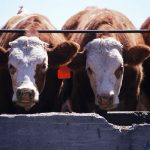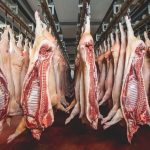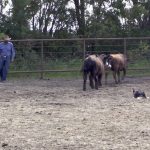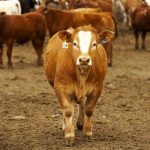
 Livestock
Livestock

Klassen: Feeder market ends year on mixed sentiment
Some feedlots becoming backed up with heavier cattle, setting negative tone for feed complex
Western Canadian feeder cattle markets were unchanged, to as much as $10 lower compared to last week.
Demand for heifers was suffering last week. A weaker tone was noted in the Eastern prairie regions as Ontario demand appeared to evaporate last week. Alberta packers were buying fed cattle on a dressed basis in the range of $368-$370/cwt, down $7-$8 from last week.

Vence virtual fence pilot starts in Saskatchewan
"We're going to just do whatever the tech is going to allow us to do."
Golden light shines through the window into Mosaic Stadium’s Harvard Lounge and onto the stage, but as John and Deanne Chuiko take the stage, the light settles on the horizon and a winter prairie night spreads through the sky. Outside, people bustle in and out of the REAL District as Agribition rages. John and Deanne […] Read more

What to consider when changing the breeding season
Producers tightening or shifting their breeding season should consider everything from economics to feeding programs
Trudging through slushy snow in April is a scene many producers know well. One day there’s a hint of summer in the air, with birds chirping in trees overhead as a farmer checks on newborn calves frolicking near puddles. The next day, the farmer is rushing through pastures as hard sleet slashes his face, trying […] Read more

Feed weekly outlook: U.S. corn imports keep lid on Prairie feed grains
Mild Prairie weather contributing to lower feed demand
Glacier FarmMedia – Feed prices for barley and wheat across much of Western Canada are very likely to remain low until the end of winter/the beginning of spring, according to Erin Harakal of Agfinity in Stony Plain, Alta.

U.S. livestock: CME hogs decline further as cattle face renewed pressure
"I think we're still trying to hunt for a bottom": analyst
Chicago Mercantile Exchange lean hog futures extended a slump, as live cattle futures came under renewed pressure with broad selling hitting agricultural markets on Wednesday.

Preparing cattle for the breeding season
Many factors influence the success of a breeding season. Bulls must be in good shape to perform. The body condition of pregnant and lactating animals greatly affects a cow or heifer’s ability to cycle and be receptive to a bull. It’s important to discuss vaccination and herd health programs, bull soundness and semen evaluation with […] Read more

Klassen: Year-end buying interest boosts feeder market
Feedlot operators gearing up for shortfall in overall numbers in the first half of 2024
Strength was noted in calves under 650 pounds while feeders over 700 pounds were relatively unchanged. Larger packages of weaned quality genetics were $8 to $10 higher in some cases.

VIDEO: Tips on ‘dog-breaking’ your cattle
Justin Hozack is a cow-calf producer who relies heavily on stock dogs to help move his cattle. “Everybody should have a stock dog. Once you have one it’s like losing your Leatherman off your belt as far as I’m concerned,” said Hozack, at Ag in Motion this past summer. Having a trained stock dog to […] Read more

Cattle prices turning lower
Market Talk with Jerry Klassen
I’ve been overwhelmed with calls over the past week as the recent issue of Canadian Cattlemen reached dinner tables and coffee shops. In the October issue, I hinted that the cattle market was turning over and would likely trend lower in the latter half of 2024. I always judge how successful my articles are by […] Read more

Tech for cattle disease diagnostics edges into the Star Trek age
Researchers are testing new, compact equipment to see if it can quickly and accurately diagnose specific pathogens that cause BRD in the field and feedlot
Remember the COVID rapid test? That was a point-of-need test designed to find a target and match it to a “binder” which then changes the colour if it’s positive or negative. The same principle is applied to the rapid lateral flow device test for anthrax, Dr. Anatoliy Trokhymchuk explains, which was developed by the U.S. […] Read more


 Livestock
Livestock
